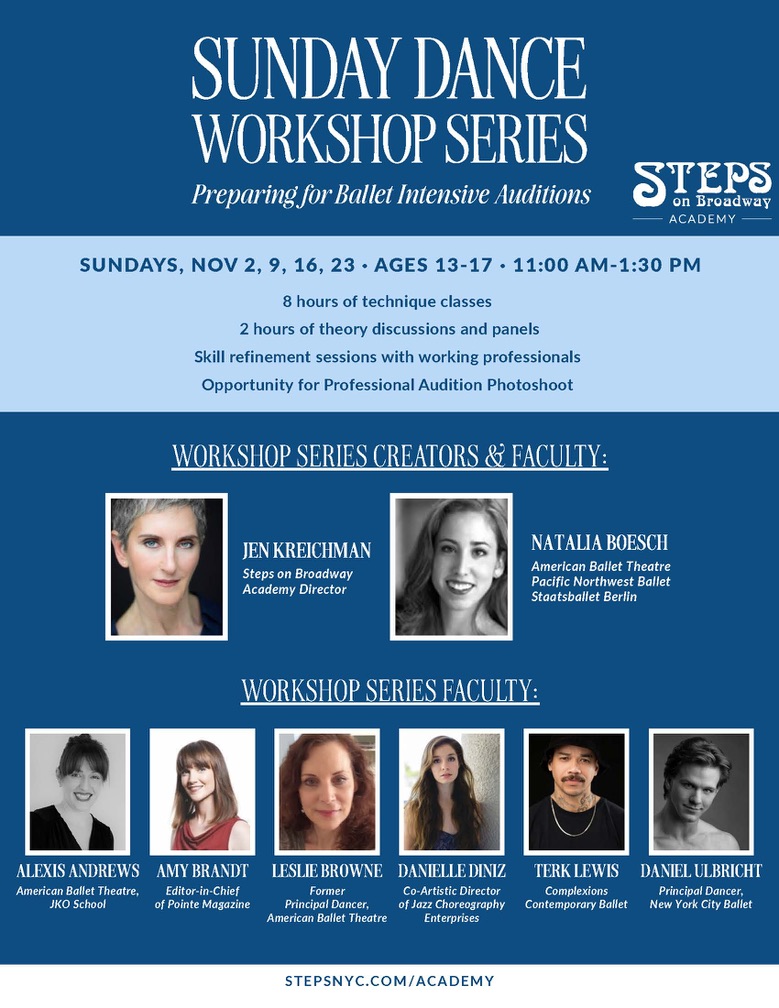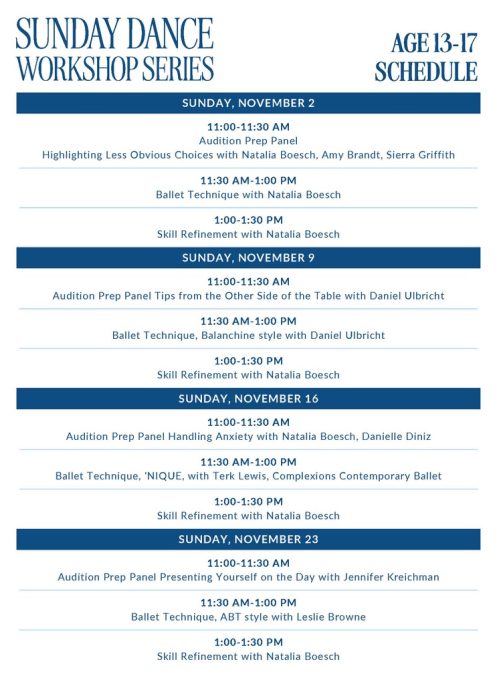NATALIA
BOESCH
NYC-Based ballet teacher and writer
about/contacT mini classes private classes
n [at] nataliaboesch.com
917.652.6654
About Natalia
Following a performance career with American Ballet Theatre, Pacific Northwest Ballet, and Staatsballet Berlin, Natalia Boesch turned her focus to teaching and writing about ballet.
Natalia currently teaches at Ballet Hispanico, Manhattan Youth Ballet (MYB), and elsewhere. The former Director of Curriculum and Head of Primary Levels for MYB, she has also been a visiting instructor at Neglia Ballet, Steps Academy, and Ballet Tech. She is an ABT Certified Teacher in levels Pre-Primary through Level Three.
Her writing has appeared in magazines including Dance, Dance Teacher, and Pointe, for which she authored wrote columns. (See below for sample articles.)
Natalia began her training at the School of American Ballet. During her ten years there, she danced with the New York City Ballet in nearly every role for children in their repertoire.
In SAB workshops, she danced works by Balanchine, most notably Harlequinade and Le Tombeau de Couperin, as well as ballets by Jerome Robbins and Christopher Wheeldon.
Upon completing her training at the Pacific Northwest Ballet School, Natalia joined the Pacific Northwest Ballet as a corps member. Under the direction of Francia Russell, she performed in many of Balanchine’s most famous ballets, including Agon, Serenade, Concerto Borocco, Western Symphony, Ballet Imperial, and La Valse.
Her repertory there also included classics such as Paquita and Ronald Hynd’s Sleeping Beauty, and newer works by Peter Martins, Kent Stowell, and Lynn Taylor-Corbett.
In 2003, Natalia joined the corps of American Ballet Theatre, where she danced for three years in all the great classics, including Swan Lake, Romeo and Juliet, Le Corsaire, Don Quixote, Giselle, and La Bayadere.
She also performed in Agnes DeMille’s Rodeo and in the premiere of Kaleidoscope by choreographer Peter Quanz. With ABT she toured all over the country as well as to Japan.
In 2008, Natalia joined the Staatsballett Berlin, under the direction of Vladimir Malakhov. As a corps member there, she performed in John Cranko’s Onegin and in the premiere of Malakhov’s La Peri, among others.
In 2010 Ms. Boesch staged and danced as a soloist in the Jen DeNike art piece Scrying, choreographed by Melissa Barak. Throughout her career, Natalia appeared as a soloist with Dances Patrelle in Manhattan.
Selected Writing
Contact
or contact Natalia directly:
n [at] nataliaboesch.com
917.652.6654
Mini Classes
Mini Classes are on pause until January.
If you would like to request a Mini Class between now and then,
write and let me know, and we’ll see what we can arrange!
What are Mini Classes?
These “Minis” are small, pre-professional ballet classes. Unlike classes at traditional ballet schools, enrollment in these classes will be capped at 12 students and are offered on an ad-hoc basis: students are welcome to participate in as many or few classes as they like and need not sign up for any more than one class at a time.
Classes are scheduled to make them a perfect supplement to other classes.
Who can enroll in Minis?
They are designed for students of ages 9 to 20 with previous ballet training.
What’s the purpose?
The small class size ensures that each student will receive exceptional personal, caring attention and instruction.
In each class, students will:
- build the solid foundation of knowledge and good habits that ballet technique requires
- learn and hone necessary skills as presented by age-appropriate challenges
How much do Minis cost?
Rates are based on class length and listed below. A discount of $5 off each class is offered if signing up for more than one class.
Where and when are they?
The schedule is below. Classes will be typically be taught near Columbus Circle or on the Upper West Side.
Who teaches Minis?
Minis will be taught by Natalia and other top-tier ballet and dance teachers. All classes are taught by Natalia unless otherwise noted.
What if I have other questions/concerns? How do I sign up?
As space is limited, students must sign-up in advance.
To do so, or for more information, reach out to Natalia at n [AT] nataliaboesch.com or (917) 652-6654 .
Sunday Dance Workshop Series:
Preparing for Ballet Intensive Auditions
Audition season is just around the corner.
It’s time to get ready.
Natalia created this workshop series in collaboration with Jennifer Kreichman, Director of the Steps on Broadway Academy, and Danielle Diniz, Freelance Choreographer and Teacher, to help young dancers prepare for Summer Intensive Auditions.
In Natalia’s fifteen years of teaching, she’s seen that much of what dancers are unhappy about after auditions—whether they stumbled out of a turn or struggled with an unfamiliar style—is due to habits.
And habits, of course, can be changed with rehearsal! So she created a program in which young dancers can practice the good habits and refine the skills they’ll need.
We know it’s a busy time of year: classes are scheduled such that they can also serve as warm-ups for Sunday afternoon Nutcracker rehearsals.
for more info visit the Steps website
or contact Natalia at n [at] nataliaboesch.com or (917) 652-6654
Private
Lessons
Natalia is available for private lessons upon request
Specialties include:
- Building confidence
- Coaching variations
- Audition videos for summer intensives and high school and college admissions
- Honing skills pinpointed in assessments (for instance at the dancer’s regular school) such as:
Strengthening turnout
Improving flexibility
Improving turns
Building strength in jumps
Improving footwork
- Injury-recovery lessons: These can be a crucial bridge between physical therapy and regular class. Without the pressure of keeping up with other dancers and the pace of a regular class–even a slow one–the dancer and teacher can both focus exclusively on the needs of recovery. Eliminating old bad habits and building good new habits through this process of focus and care can ensure that the dancer recovers not just completely, but stronger, better, and more knowledgeable about their own physicality and power.



